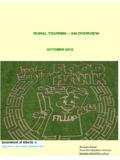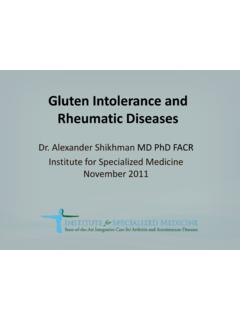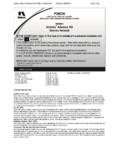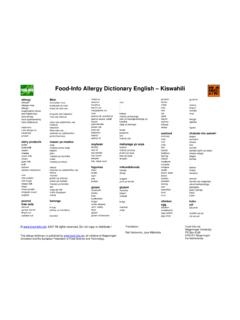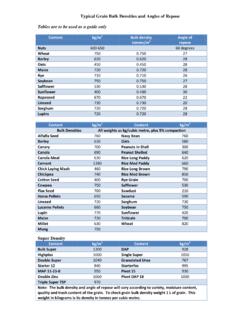Transcription of Comparative yield and feeding value of barley, oat …
1 Comparative yield and feeding value of barley , oat and triticale silages D. H. McCartney and A. S. Vaage Agriculture and Agri-Food Canada, Research Station, Box 7240, Melfort, Saskatchewan, Canada SOE 7AO. Contribution no. 7099, received 74 July 7993, accepted 20 October 7993. McCartney, D. H. and Vaage, A. S. 1994. Comparative yield and feeding value of barley , oat and triticale silage . Can. J. Anim. Sci. 74: 91-96. The yield and feeding value of barley (Hordeum vulgare 'Johnson'), oat (Avena sativa 'Calibre') and triticale (Triticosecale 'Carmen') silages were compared in a field study, a heifer growth trial (1 19 d in length, with four pens of eight Charolais cross heifers (average body weight 300 kg) per treatment), and a sheep digestibility trial (total fecal collection with eight sheep per treatment). The swathed and chopped plant material was ensiled in stack silos covered with plastic. Yields of dry matter (DM) and crude protein (CP) did not differ significantly (P > ) among species.
2 At harvest, oat and triticale had greater acid detergent fiber (ADF) levels than barley . After ensiling, triticale alone had greater neutral detergent fiber, ADF and acid detergent insoluble nitrogen levels than the other silages. The three silages did not otherwise differ in chemical composition. Heifer intakes of barley ( kg d-l) and oat ( kg d-') silage DM were similar, and greater than for triticale ( kg d-I). Average daily gain was greatest with barley ( kg d-I), intermediate with oat ( kg d-I) and least with triticale ( kg d-I). Intake of silage DM by the sheep was greatest with barley silage (741 g d-I), intermediate with oat (617 g d-I) and least with triticale (434 g d-I), which appeared less palatable than the other silages. Dry matter and CP digestibilities were greatest for barley silage ( and , versus and for oat, and and for triticale , respectively). Oat silage had the lowest fiber digestibility.
3 Sheep given triticale silage had lower rumen fluid volatile fatty acid concentrations, apparently due to low DM intake. Oat silage gave a greater molar proportion of acetate, a lower proportion of propionate, and a higher acetate to propionate ratio than either barley or triticale . triticale silage produced a greater molar proportion of acetate and a lower proportion of butyrate than barley silage . Based on animal performance, it was concluded that barley silage was the preferred of the three cereal silages for growing cattle. triticale produced a less acceptable silage due to poor palatability and low DM intake. Key words: Cattle, sheep, cereal silage , forage quality, digestibility McCartney, D. H. et Vaage, A. S. 1994. Rendement et valeur bromatologique d'ensilages d'orge, d'avoine et de triticale . Can. J. Anim. Sci. 74: 91-96. Nous avons compare le rendement et la valeur fourragkre d'ensilages d'orge (Hordeum vulgare 'Johnson'), d'avoine (Avena sativa 'Calibre') et de triticale (Triticosecale 'Carmen'), par une Ctude au champ, par un essai de croissance sur gCnisses et par un essai de digestibilitk sur moutons.
4 Pour l'essai de croissance, on utilisait quatre enclos de huit gCnisses croisCes Charolais (poids rnoyen de 300 kg) par traitement et, pour l'essai de digestibilitk, on recueillait les feces totales de huit moutons par traiternent. Les fourrages r6coltCs par la faucheuse-andaineuse, puis hichis, Ctaient conservCs en silo-meule recouverts de bsches de plastique. Le rendernent de rnatibe skche ( ) et de protiine brute (PB) ne diffkrait pas significative- rnent (P > 0,05) entre les espkces. A la rCcolte, l'avoine et le triticale avaient des niveaux plus ClevCs de lignocellulose (ADF) que l'orge rnais seul l'ensilage de triticale avait des niveaux de FDN, de lignocellulose et d'azote insoluble au dktergent acide supCrieurs B ceux des autres ensilages. Aucune autre diffkrence importante n'itait relev& dans la composition chirnique des trois ensilages. Les taux d'ingestion des ensilages d'orge et d'avoine (6,06 et 5,70 kg j-') Ctaient supCrieurs ?
5 I celui de l'ensilage de triticale (4,86 kg). C'est l'orge qui dornait lieu au GMQ le plus BevC (0,65 kg j-I), suivi de l'avoine, (0,57), puis en dernier du triticale (0,49 kg). De meme, les niveaux d'ingestion respectifs des trois ensilages par les moutons Ctaient, dans le m&me ordre, de 741, 617 et 434 g j-'. L'ensilage de triticale paraissait moins appktant que les autres ensilages. Les valeurs les plus ClevCes de digestibilitk de et de PB Ctaient obtenues pour l'ensilage d'orge, soit respectivernent 64,2 et 71,6%, contre 58,3 et 61,1% pour l'avoine et 58,8 et 65,4% pour le triticale . L'ensilage d'avoine affichait la rnoins borne digestibilitk de la fibre. Le jus du rurnen des moutons nourris au triticale contenait des concentrations moins fortes d'acide volatils, apparernment reliks B un faible niveau d'ingestion de matikres skches. L'ensilage d'avoine produisait des proportions molaires plus fortes d'acktate, moins fortes de propionate et un rapport plus ClevC acCtate1propionate dans le jus ruminal que l'orge ou le triticale .
6 Enfin, l'ensilage de triticale produisait une plus forte proportion rnolaire d'acktate et une proportion rnoindre de butyrate que l'ensilage d'orge. En s'appuyant sur les performances zootechniques, les auteurs concluent que l'ensilage d'orge Ctait l'ensilage prCfCrC des bovins en croissance. Le triticale fournissait un ensilage moins acceptable B cause de sa pibtre appktence pour les animaux et de son faible niveau d'ingestion. Mots cles: Bovin, mouton, ensilage de cCrCale, qualit6 des fourrages, digestibilitk Cereal crops, ensiled at the soft dough stage, are high and in vitro digestibility of small grain species grown yielding, reliable sources of conserved forage for over- for forage. However, little Comparative information on wintering cattle in Western Canada. Numerous agronomic animal performance is available, especially for the Canadian studies have compared the yield , chemical composition Prairie.
7 91 92 CANADIAN JOURNAL OF ANIMAL SCIENCE As forage, oat generally out-yields other cereal crops such as barley , wheat, triticale and rye (Lawes and Jones 1971; Berkenkarnp and Meeres 1987a,b, 1988; Baron et al. 1992). However, depending on the cultivar, stage of growth, year, and location, barley and triticale yields can be comparable with that of oat (Tingle and Dawley 1974; Cherney and Marten 1982; Helsel and Thomas 1987; Berkenkamp and Meeres 1988). In contrast to yield , the nutritional value of oat is generally lower than for other cereals. Crude protein (CP) concentrations tend to be higher in wheat, triticale and barley than in oat silage (Tingle and Dawley 1974; Christensen et al. 1977; Berkenkamp and Meeres 1988). In vitro dry matter (DM) and organic matter (OM) digestibilities appear to be greatest for barley and lowest, again, for oat silage (Fisher and Fowler 1975; Nass et al. 1975; Cherney and Marten 1982).
8 The CP content and in vitro digestibility of cereal forages grown at Lacombe and Brooks, Alberta were greatest for wheat and triticale , intermediate for barley , and lowest for oat (Baron et al. 1992). Intake of oat silage by growing steers was greater than either barley or wheat silage (Christensen et al. 1977); however, barley and wheat silages were more digestible than oat silage . barley , wheat and oat had similar energy and pro- tein digestibilities when ensiled in experimental, steel culvert silos and fed to 230 kg steers (Hingston and Christensen 1982). In a second experiment using both experimental and bunker silos, Hingston and Christensen (1982) found that, with steers, oat silage protein and energy digestibilities were lower than for barley or wheat silage , whereas energy intakes did 'not differ among the forages due to greater (non- significant) oat silage DM intake. barley silage gave greater average daily gains (ADG) with growing steers than did either wheat or oat silage (Oltjen and Bolsen 1980).
9 Animal performance with the barley silage was at times comparable with corn silage , while oat silage gave the poorest performance. Intake, apparent digestibility and milk produc- tion were lower with triticale silage than with corn silage (Fisher 1972). ZoBell et al. (1992) found that barley and triticale silages produced similar body weight, intake, ADG and feed efficiency when fed with barley grain, at relatively low levels ( of the diet), to 260 kg feedlot steers. The economic value of a cereal forage for feeding cattle is dependant on both its yield and feeding value ( , chemical composition, digestibility and anunal perfonnance). As silage , the yield advantage of oat may be offset by its lower feeding value relative to barley . Furthermore, the relative value of a given species or cultivar also appears to vary with location ( , soil type). Oat and barley are the most common cereal crops grown for silage in the Aspen Parkland region of the Canadian Prairies, but there has been increased interest in growing triticale , for which little information exists.
10 The present study was therefore undertaken to compare both the yield and feeding value of barley , oat and triticale silage produced in the black soil zone of the Aspen Parkland of Western Canada. MATERIALS AND METHODS yield and Chemical Composition Four fields ranging in size from to ha were each divided into three equally sized areas and seeded with barley (Hordeurn vulgare 'Johnson', 28 May 1990), oat (Avena sativa 'Calibre', 25 May 1990) or triticale (Triticosecale 'Carmen', 24 May 1990). Each treatment was randomly assigned to one of the plots within each field. Seeding rates were k ha-' for barley , kg ha-' for oat and F kg ha- for triticale . These seeding rates were based on a recommended volumetric rate of m3 ha-' (B. Berkenkamp, personal communication). All fields were fertilized with urea (146 kg ha-') and monoammonium phosphate (90 kg ha -I). barley was harvested at the soft dough stage between 1 August and 3 August 1990, triticale was harvested between the milk and soft dough stage on 9 August and 10 August 1990, and oat was harvested predominantly at the milk stage on 14 August 1990.





